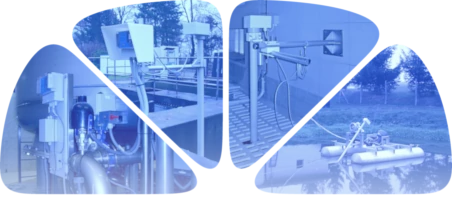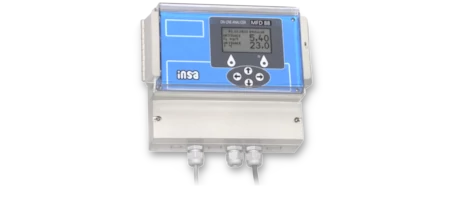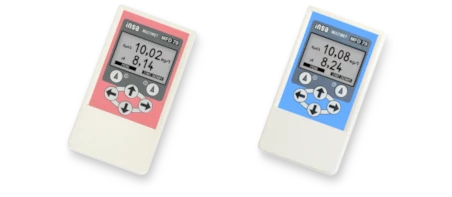Chlorine concentration: Sensors
Appropriate sensor is fundamental to any measurement setup. Variety of different types and variants are available, depending on the measured quantities, sensor dimensions, as well as usage workflow, environment, and installation method. The vast majority of sensors listed below are just components of a larger measurement setup, and can therefore be satisfactorily used only with a compatible analyzer. Sensors for in-technology measurements should be installed inside our probes, ensuring their fixing and protection, and these connect to a terminal block. Variants for laboratory and portable usage are terminated with the appropriate connector. Sensors generally have the shortest lifetime of the entire setup, due to direct contact with the measured medium.
Chlorine sensors CSCT43 and CSUT43
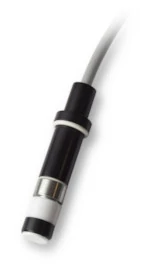
CSCT43 and CSUT43 sensors are amperometric membrane-based sensors designed to measure chlorine concentration (and also temperature) in water, primarily for the purpose of continuous technology control. The output is mostly not affected by other substances in the water, further advantages are easy operation and resistance to pollution. However, regular calibration is required for correct measurement (e.g. by determining chlorine using the DPD method).
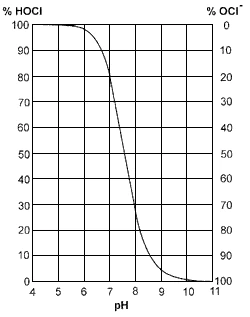 These sensors are based on a pair of electrodes immersed in an electrolyte, separated from the measured environment by a membrane permeable to chlorine (but also to other gases, such as O2, O3, ClO2, CO2). Chlorine (hypochlorous acid, hypochlorite ion) is reduced at the cathode, resulting in the generation of an electric current proportional to the partial pressure of HOCl (CSCT43-R), or HOCl + OCl- (CSUT43-R). The sensors consume chlorine (hypochlorous acid, hypochlorite ion), which is taken from the measured environment, and thus all factors influencing the rate of diffusion to the cathode surface take effect. The output current also depends on temperature, which INSA analyzers compensate based on readings from the sensor's built-in thermometer.
These sensors are based on a pair of electrodes immersed in an electrolyte, separated from the measured environment by a membrane permeable to chlorine (but also to other gases, such as O2, O3, ClO2, CO2). Chlorine (hypochlorous acid, hypochlorite ion) is reduced at the cathode, resulting in the generation of an electric current proportional to the partial pressure of HOCl (CSCT43-R), or HOCl + OCl- (CSUT43-R). The sensors consume chlorine (hypochlorous acid, hypochlorite ion), which is taken from the measured environment, and thus all factors influencing the rate of diffusion to the cathode surface take effect. The output current also depends on temperature, which INSA analyzers compensate based on readings from the sensor's built-in thermometer.
The measured data are somewhat different in nature from the results determined by the DPD method. Dosing chlorine in the form of gas or hypochlorites produces (simplified) hypochlorous acid (HOCl) and hypochlorite ion (OCl-), which are in mutual balance, dependent on the pH value (see figure). If ammonium ions are present in the water, then chloramines will also appear. Hypochlorous acid (and free chlorine gas, if present) is an effective disinfectant, with a power 20 to 100 times greater than the disinfecting power of the hypochlorite ion. The CSCT43 sensor measures the concentration of elemental chlorine and hypochlorous acid, so its signal is independent of the pH value up to approximately 5.0, at higher values it then decreases according to the indicated curve. The signal of CSUT43 sensor is proportional to the concentration of both hypochlorous acid and hypochlorite ion.
When free chlorine is determined by the DPD method, elemental chlorine, hypochlorous acid and hypochlorites are determined. When determining total chlorine (total residual chlorine) using the DPD method, elemental chlorine, hypochlorous acid, hypochlorites and chloramines are then determined. Both of these values are usually higher than the value obtained by the CSCT43-R sensor.
It also follows from the above that the CSCT43-R is an ideal sensor for measurements of chlorine in swimming pools, where the disinfection efficiency of the dosed agent (i.e. the concentration of hypochlorous acid) needs to be controlled, and the pH value does not fluctuate much. The CSUT43-R sensor is suitable where it is necessary to measure the content of free chlorine and the pH value fluctuates.
| Type | Suitable for | Dimensions | pH range | Flow of the sample | Output proportional to |
| CSCT43PS-R | Installation with SPO41, SPO41K, SPO42, SPO41MEK, PB42V, PB43V, PE G3/4K | Ø14.5 x 57 mm | 4 - 7.8 | min. 20 cm/s | partial pressure of hypochlorous acid and elemental chlorine (disinfection power), depends on the pH value |
| CSCT43PL-R | Installation with SPR42, SPR41ME, PE G3/4L, SVK42 | Ø14.5 x 113 mm | 4 - 7.8 | min. 20 cm/s | partial pressure of hypochlorous acid and elemental chlorine (disinfection power), depends on the pH value |
| CSUT43PS-R | Installation with SPO41, SPO41K, SPO42, SPO41MEK, PB42V, PB43V, PE G3/4K | Ø14.5 x 57 mm | 5.5 - 9.0 | min. 4 cm/s (0.3 l/min supply to PB42/43) | concentration of both hypochlorous acid and hypochlorite ion |
| CSUT43PL-R | Installation with SPR42, SPR41ME, PE G3/4L, SVK42 | Ø14.5 x 113 mm | 5.5 - 9.0 | min. 4 cm/s (0.3 l/min supply to PB42/43) | concentration of both hypochlorous acid and hypochlorite ion |
| Principle | Amperometric membrane-based sensor | ||||
| Measurement range | 0.01 - 5.0 mg/l | ||||
| Operating temperature | 1 - 40 °C | ||||
| Zero signal fluctuation | typ. ±0.02 mg/l | ||||
| Output current | ca 2 x 10-9 A (at 1 mg/l, 25 °C) | ||||
| Materials in contact with medium | Polyethylene terephthalate, PTFE, silicone, stainless steel | ||||
